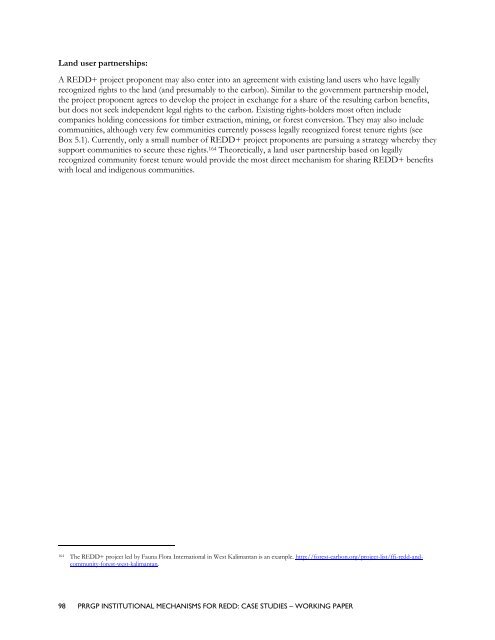Institutional Mechanisms for REDD+ - Case Studies Working Paper
Institutional Mechanisms for REDD+ - Case Studies Working Paper
Institutional Mechanisms for REDD+ - Case Studies Working Paper
You also want an ePaper? Increase the reach of your titles
YUMPU automatically turns print PDFs into web optimized ePapers that Google loves.
Land user partnerships:<br />
A <strong>REDD+</strong> project proponent may also enter into an agreement with existing land users who have legally<br />
recognized rights to the land (and presumably to the carbon). Similar to the government partnership model,<br />
the project proponent agrees to develop the project in exchange <strong>for</strong> a share of the resulting carbon benefits,<br />
but does not seek independent legal rights to the carbon. Existing rights-holders most often include<br />
companies holding concessions <strong>for</strong> timber extraction, mining, or <strong>for</strong>est conversion. They may also include<br />
communities, although very few communities currently possess legally recognized <strong>for</strong>est tenure rights (see<br />
Box 5.1). Currently, only a small number of <strong>REDD+</strong> project proponents are pursuing a strategy whereby they<br />
support communities to secure these rights. 164 Theoretically, a land user partnership based on legally<br />
recognized community <strong>for</strong>est tenure would provide the most direct mechanism <strong>for</strong> sharing <strong>REDD+</strong> benefits<br />
with local and indigenous communities.<br />
164 The <strong>REDD+</strong> project led by Fauna Flora International in West Kalimantan is an example. http://<strong>for</strong>est-carbon.org/project-list/ffi-redd-andcommunity-<strong>for</strong>est-west-kalimantan.<br />
98 PRRGP INSTITUTIONAL MECHANISMS FOR REDD: CASE STUDIES – WORKING PAPER

















